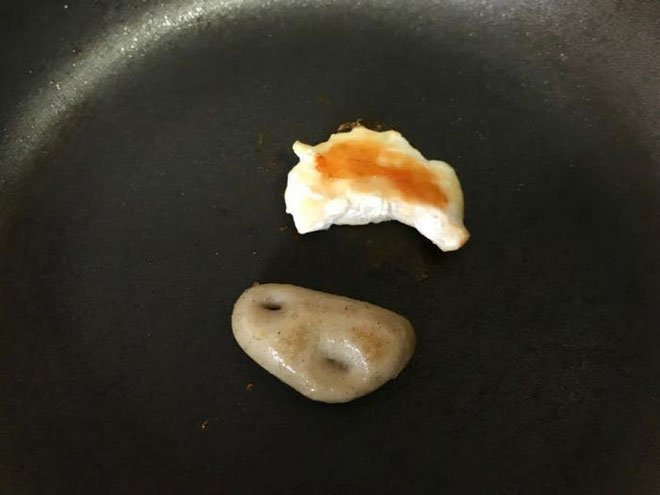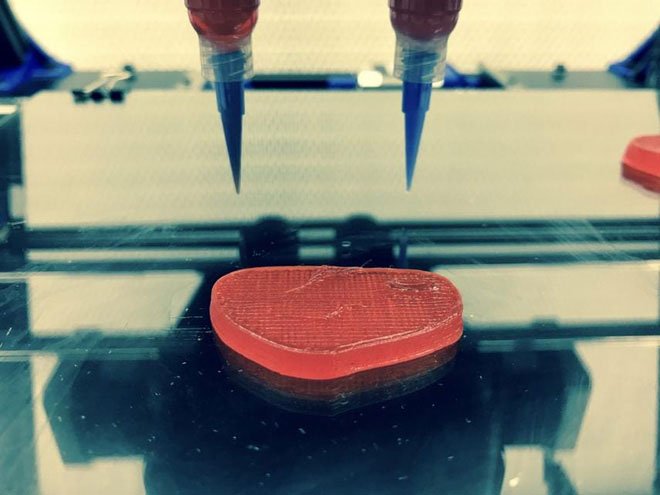Italy uses 3D printing technology to create 'vegetarian meat', addressing the food crisis in the future
It sounds like fiction, but recently Giuseppe Scionti - an Italian researcher - has found a way to use vegetable protein to "print" vegetarian meat pieces through 3D printing technology.
According to Scionti, this is the result of more than 10 years of research from many biochemistry experts - looking to apply printing technology to create tissues, including testing to create corneas. as well as artificial leather.
Now, this technology is starting to be refined for application in the food sector, thereby helping us to create artificial meat by 3D printing.

Below is a piece of artificial chicken being fried - but still looks far behind the real chicken above.
Last November, Scionti officially launched an artificial meat company called Nova Meat . This "meat printing" technology is only at the experimental stage, but Scionti has obtained some positive results. In particular, the most remarkable thing is that he was able to create a piece of artificial beef with texture not unlike normal beef.
"The biggest obstacle to making artificial meat is that the texture is not like the meat . We can now create vegetarian meat pieces that taste exactly like fine meat, but chew the pieces. that meat is often seen only as fluttering as meat grinded ".

The "meat printing" like this is very environmentally friendly.
At the present time, printing 100g of meat with 3D printing technology costs about $ 3, which is still quite high compared to the price of conventional meat outside the supermarket. However, according to Scionti, when this technology reaches perfection to be able to be applied to mass production, the cost of printing meat will be significantly reduced.
Another plus of this artificial meat is that although it is made of amino acids in legumes, the end product has the same nutritional value as a piece of real beef. Besides, the "meat printing" like this is also extremely environmentally friendly.
"We select materials that do not cause negative environmental impacts. The materials that are likely to be in scarcity when we conduct large-scale production are not public choices. ty ".

At the moment, printing 100g of meat using 3D printing technology costs about $ 3.
The biggest problem to solve for this type of meat is how they taste exactly the same as the actual pieces of meat , and Scionti is starting to work with talented chefs to find an answer.
In the face of the current situation with the risk of future food shortages, it is becoming more and more urgent to create alternatives such as artificial meat. Not only Scionti and Nova Meat, many other projects in the world are also working to find ways to solve this problem. This makes the very special market segment of artificial meat is increasingly expanding, but also makes Scionti face more competitors in the market. Even, one of the very giant corporations in the world, Unilever, is investing heavily in a project to create vegetable products that taste just like meat.
"This is a very favorable time for many big companies to jump into this market," Scionti said.
- Israel develops meat products using 3D printing technology
- For the first time beef was produced in space
- Israel develops meat products with 3D printing technology
- How does the body change when we switch from meat to vegan?
- Magic 3D printing technology
- What do you know about 'vegetarian' meat?
- 3D printers produce cheese that tastes like a real taste
- Revealing how Impossible Food turns vegetables into meat
- Without rice, what will humans eat?
- There is an opportunity to 'enjoy' artificial meat
- Video: Food printing restaurant with the world's first 3D technology
- Will salty wheat solve the food crisis?
- Unbelievable applications of 3D printing technology
- Learn about 3D printing technology
 The US company is about to build a supersonic passenger plane of 6,000km / h
The US company is about to build a supersonic passenger plane of 6,000km / h Japan develops avatar robot as in fiction film
Japan develops avatar robot as in fiction film Australia tested the world's first mango picking robot
Australia tested the world's first mango picking robot America develops technology to separate water from animal waste
America develops technology to separate water from animal waste This extremely famous type of meat is good for both men and women. During Tet, you should use it to nourish your body.
This extremely famous type of meat is good for both men and women. During Tet, you should use it to nourish your body.  Eel meat is very nutritious, but who should not eat eel meat?
Eel meat is very nutritious, but who should not eat eel meat?  Strange animal 'tastes better than dragon meat', costs only 500,000 VND/kg but farmers don't want to raise it
Strange animal 'tastes better than dragon meat', costs only 500,000 VND/kg but farmers don't want to raise it  Is it harmful to eat 'buried pork' buried underground for 2-3 years?
Is it harmful to eat 'buried pork' buried underground for 2-3 years?  Find out the cause of colorectal cancer increase in young people
Find out the cause of colorectal cancer increase in young people  How to choose delicious kitchen buffalo meat is extremely simple
How to choose delicious kitchen buffalo meat is extremely simple 